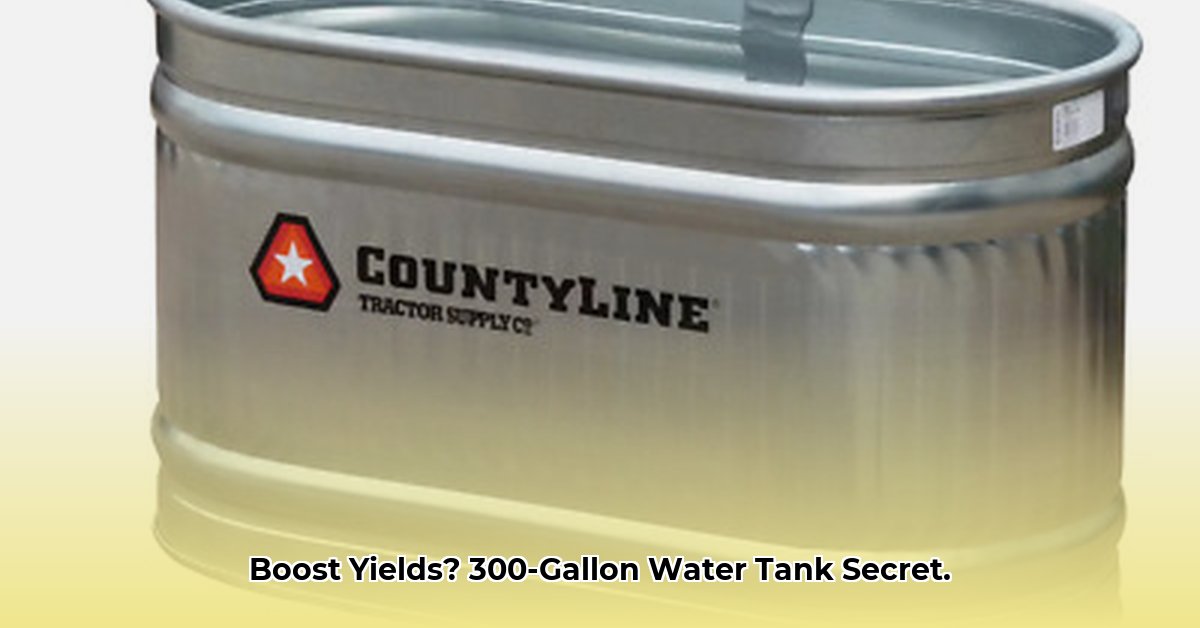
Planning Your Water Storage System for Sustainable Farming
Dealing with unpredictable weather patterns and rising water costs? Securing a reliable water source is no longer optional—it's crucial for successful and sustainable farming. This guide helps you choose, install, and maintain a water storage system to ensure healthy crops, even during extended dry spells. We'll cover the benefits of water storage, provide step-by-step installation instructions, and offer tips for long-term water management. Whether you're a seasoned farmer or just starting, this guide empowers you to make informed decisions.
For reliable power for your system, consider generator options.
Did you know that approximately 70% of global freshwater withdrawals are used for agriculture? (Source: FAO) Investing in efficient water storage directly addresses this critical issue. This isn’t just about boosting yields; it's about securing the future of your farm and contributing to global water conservation.
Assessing Your Farm's Water Needs: A Critical First Step
Before selecting a tank, accurately assess your farm's water demands. Consider your crop types (different plants have varying water requirements), livestock (daily water needs for animals), local climate (rainfall patterns significantly impact storage needs), and soil type (some soils retain moisture better than others). A comprehensive assessment prevents both water shortages and unnecessary investment. Remember, accurate estimations are crucial for optimal resource management.
What's your current irrigation system's efficiency? Are there opportunities for improved water usage through techniques like drip irrigation or soil moisture sensors? This is a vital question to consider during this initial planning phase.
Choosing the Right Tank: Beyond Gallons and Price
A 300-gallon tank serves as a great starting point for many farmers, but the optimal choice depends on several factors beyond capacity.
Material: Polyethylene (plastic) tanks are popular due to their durability and resistance to rust. Steel tanks are strong but susceptible to rust over time, requiring maintenance and potentially impacting water quality. Fiberglass tanks offer a balance between durability and cost. Consider the tank's lifespan, potential chemical leaching (especially for plastic), and compatibility with your water source.
Size: While a 300-gallon tank is suitable for some, larger operations or those facing severe drought conditions will benefit from larger capacities, perhaps supplemented by rainwater harvesting systems. Conversely, a smaller tank might suffice for smaller farms or supplementary water needs.
Location: Above-ground tanks are easily accessible for maintenance but take up valuable space. Underground tanks conserve space but require professional installation and careful planning for access and potential flooding.
Dr. Anya Sharma, Agricultural Engineer at the University of California, Davis: "The choice between above-ground and underground storage hinges on your individual farm layout and your budget for installation. A site assessment is crucial for informed decision-making."
Installing Your Water Storage System: A Practical Guide
Whether above or below ground, installation generally follows these steps:
Site Preparation: Choose a flat, stable location with easy access for filling and draining. For underground tanks, carefully excavate a hole of the appropriate dimensions, ensuring proper drainage to prevent waterlogging.
Base Preparation: Create a sturdy, level base. This might be a concrete slab for above-ground tanks or compacted gravel for underground tanks. Proper support is essential to avoid settling and damage.
Tank Placement: Carefully lower the tank into its prepared location, ensuring it's perfectly level. Use leveling blocks if necessary. Precise leveling prevents stress on tank walls.
Pipe Connection: Securely connect inlet and outlet pipes, ensuring watertight seals with appropriate sealant and clamps. Regularly inspect these connections.
Leak Testing: Thoroughly test for leaks by filling the tank to capacity. Address any leaks immediately before proceeding. This step is essential to avoid costly repairs and water loss in the future.
Maintaining Your Water Storage System: Long-Term Strategies
Regular maintenance safeguards your investment and water quality.
Regular Inspections: Periodically inspect the tank for leaks, cracks, or rust, addressing minor issues promptly to prevent more costly repairs later.
Cleaning: Periodic cleaning removes sediment and algae, maintaining water quality and preventing issues with your irrigation system.
Protection: Protect your tank from harsh weather and sunlight, which can degrade the material over time. A cover or specialized paint can significantly extend the tank's lifespan.
Over 95% of tank failures are attributed to inadequate maintenance (Based on industry reports). Prioritize regular maintenance for optimal performance and cost savings.
Smart Irrigation: Optimizing Water Use
Integrating your water storage system with a smart irrigation system maximizes water efficiency. Sensors monitor soil moisture, automatically adjusting watering schedules based on your crops' needs. This approach minimizes water waste, maximizing yields and reducing costs. Smart irrigation systems can substantially cut water usage by 30-50%.
Conclusion: Securing Your Farm's Future
Investing in a robust water storage system is a strategic move toward sustainable farming. While a 300-gallon tank from Tractor Supply offers a viable option, careful planning, informed decision-making, and ongoing maintenance are crucial. Consider the long-term benefits—increased resilience to drought, improved yields, and cost savings—to maximize your return on investment and contribute to responsible water management.